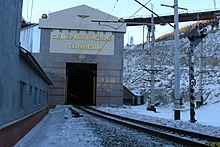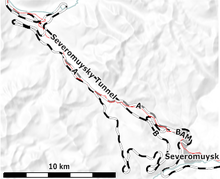Severomuysky Tunnel
Severomuysky Tunnel (Russian: Северому́йский тонне́ль) is a railroad tunnel on the Baikal Amur Mainline (BAM), in northwestern Buryatia, Russia. It is named after the Severomuysky Range it cuts through. The tunnel is 15.343 kilometres (9.534 mi) long, the longest in Russia (excluding metro lines).
 Severomuysky Tunnel, Eastern Portal | |
| Overview | |
|---|---|
| Location | Buryatia, Russia |
| Coordinates | 56°14′26″N 113°26′30″E |
| Status | open |
| Route | BAM |
| Operation | |
| Work begun | 5/28/1977 |
| Opened | 12/05/2003 |
| Technical | |
| Length | 15,343 m (50,338 ft) |
| No. of lanes | 1 |
Geography
The tunnel cuts under the Severomuysky Range, a mountain ridge separating the Upper Angara basin to the north west from the Muya basin to the south east. The BAM then follows the valley of the Muyakan River on its way east towards its junction with the Muya shortly before Taksimo. A works town named after the tunnel was built at each end during its construction; Tonnelny at the western portal and Severomuysk at the eastern portal. Tonnelny was abandoned in 2004 after the opening of the tunnel and its population relocated to Severomuysk. Employment in Severomuysk relies almost entirely on the maintenance of the tunnel and its bypass route.
History

Preliminary work on the tunnel started in 1975, with tunneling commencing on May 28, 1977. The tunnel was built through very difficult rock with four major faults and a great deal of underground water, some at 35 standard atmospheres (3.5 MPa) pressure. One method used was to pump liquid nitrogen into the rock, freezing the water until the cut could be sealed. In September 1979 workers broke into a fault connected to a 12,000 cubic metres (3,200,000 US gal) underground lake. This required building a drainage tunnel and delayed work for eighteen months.
When it became clear that the tunnel would not be completed in time for the planned official opening of the BAM in 1984, a 28 kilometres (17 mi) bypass was built during the years 1982-83. This had a 4% grade and traffic was limited to 15 kilometres per hour (9 mph). Passenger traffic was prohibited.
In 1989, a new bypass of 54 kilometres (34 mi) was completed (with a 2% ruling grade) and the original bypass route was closed. The new route was open for passenger trains, although it required auxiliary engines to push trains up steep sections and was limited to a maximum speed of 20 kilometres per hour (12 mph), the 54 kilometres (34 mi) route taking around 21⁄2 hours to cross. This section featured a large number of tight curves and viaducts, with the long curved bridge built near the tunnel's western portal being nicknamed locally the Devil's Bridge. It also included two of its own, one of which was 2 kilometres (1.2 mi) in length. It was also expensive to maintain and at risk of avalanches.
The tunnel was put into operation on December 5, 2003[1] (signed off on November 30[2][3]), with yet another announcement of the completion of the BAM project.
Current status
.jpg)
.jpg)
.jpg)
.jpg)
With the opening of the tunnel, the time required for a train to cross the section has been reduced to only 15 minutes. However, the newer bypass is still sometimes used for goods traffic to allow other trains to pass through the single-track tunnel. The opening of the tunnel also allowed 6 million t (6.6 million short tons) of freight annually to be switched onto the BAM from the Trans-Siberian Railway.[4]
Future
The cost of doubling the tunnel to increase the capacity from 16 to 34 train pairs per day and from 16 to 100 million t (18 to 110 million short tons) per year, with intervals between trains of not more than 10 minutes, was budgeted at 260.79 billion rubles (US$4.47 billion), according to a 2018 feasibility study by the Institute for Economy and Transport Development. Building a second tunnel would take approximately ten years.[5]
References
- РОФ Фонд Святого Всехвального апостола Андрея Первозванного :: Комитет по международной премии :: Лауреаты Archived 2007-09-27 at the Wayback Machine
- Baikal-Amur Mainline completed Archived 2007-09-29 at Archive.today (an October 29, 2003 Pravda Online article (in English))
- babr.ru: 30 October 2003 News Archived 12 March 2007 at the Wayback Machine (in Russian)
- Baikal - Amur Main Line description on website of the Russian Railways
- "Press review: Ukraine's Kerch Strait provocation fails and Kiev picks new Normandy envoy". Kommersant. TASS. 26 November 2018. Retrieved 26 November 2018.
Athol Yates and Nicholas Zvegentzov, Siberian BAM guide, 2001